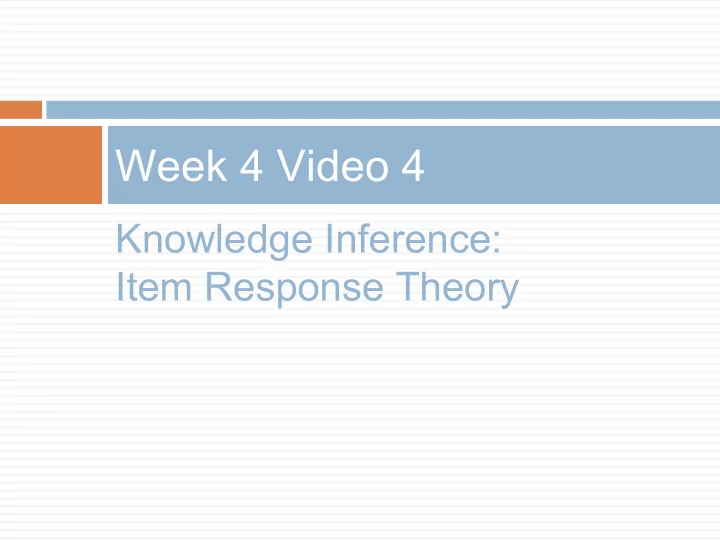

Week 4 Video 4 Knowledge Inference: Item Response Theory
Item Response Theory A classic approach for assessment, used for decades in tests and some online learning environments In its classical form, has some key limitations that make it less useful for assessment in online learning But variants such as ELO and CDM address some of those limitations
Key goal of IRT Measuring how much of some latent trait a person has How intelligent is Bob? How much does Bob know about snorkeling? SnorkelTutor
Typical use of IRT Assess a student’s current knowledge of topic X Based on a sequence of items that are dichotomously scored E.g. the student can get a score of 0 or 1 on each item
Key assumptions There is only one latent trait or skill being measured per set of items This assumption is relaxed in the extension Cognitive Diagnosis Models (CDM) (Henson, Templin, & Willse, 2009) No learning is occurring in between items E.g. a testing situation with no help or feedback
Key assumptions Each learner has ability θ Each item has difficulty b and discriminability a From these parameters, we can compute the probability P( θ ) that the learner will get the item correct
Note The assumption that all items tap the same latent construct, but have different difficulties Is a very different assumption than is seen in PFA or BKT
The Rasch (1PL) model Simplest IRT model, very popular Mathematically the same model (with a different coefficient), but some different practices surrounding the math (that are out of scope for this course) There is an entire special interest group of AERA devoted solely to the Rasch model (RaschSIG) and modeling related to Rasch
The Rasch (1PL) model No discriminability parameter Parameters for student ability and item difficulty
The Rasch (1PL) model Each learner has ability θ Each item has difficulty b
Item Characteristic Curve A visualization that shows the relationship between student skill and performance
As student skill goes up, correctness goes up This graph represents b=0 When θ =b (knowledge=difficulty), performance = 50%
As student skill goes up, correctness goes up
Changing difficulty parameter Green line: b=-2 (easy item) Orange line: b=2 (hard item)
Note The good student finds the easy and medium items almost equally difficult
Note The weak student finds the medium and hard items almost equally hard
Note When b= θ Performance is 50%
The 2PL model Another simple IRT model, very popular Discriminability parameter a added
Rasch 2PL
Different values of a Green line: a = 2 (higher discriminability) Blue line: a = 0.5 (lower discriminability)
Extremely high and low discriminability a=0 a approaches infinity
Model degeneracy a below 0…
The 3PL model A more complex model Adds a guessing parameter c
The 3PL model Either you guess (and get it right) Or you don’t guess (and get it right based on knowledge)
Fitting an IRT model Can be done with Expectation Maximization As discussed in previous lectures Estimate knowledge and difficulty together Then, given item difficulty estimates, you can assess a student’s knowledge in real time
Uses… IRT is used quite a bit in computer-adaptive testing Not used quite so often in online learning, where student knowledge is changing as we assess it For those situations, BKT and PFA are more popular
ELO (Elo, 1978; Pelanek, 2016) A variant of the Rasch model which can be used in a running system Continually estimates item difficulty and student ability, updating both every time a student encounters an item
ELO (Elo, 1978; Pelanek, 2016) ! "#$ = ! " + ' () − + ) ) - "#$ = - " + ' () − + ) ) Where K is a parameter for how strongly the model should consider new information
Next Up Advanced BKT
Recommend
More recommend